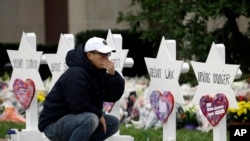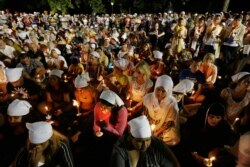For the first time in four years, hate crimes fell slightly in the United States in 2018, according to the FBI’s annual statistics released on Tuesday.
Law enforcement agencies reported 7,120 bias-motivated incidents to the FBI in 2018 — down from 7,175 in 2017 — the report showed.
Despite the downtick in incidents, the year was the deadliest on record for hate crimes. Law enforcement agencies reported 24 homicides classified as hate crimes, the most on record, and 3,099 violent hate crime offenses, the highest level since 2001.
“The FBI’s 2018 hate crime data confirm what we already know: communities continue to face hate in America and the violence is getting worse,” said Maya Berry, executive director of the Arab American Institute.
The slight decline in reported hate crime incidents followed a spike of more than 30% during the prior three years, and came as a smaller number of police departments participated in the annual report.
Among the report’s key findings:
- Anti-Muslim hate crime dropped for the second year in a row, from 273 in 2017 to 188 last year. Attacks on the Muslim-American community had trended higher every year between 2014 and 2016 amid a backlash against terrorist attacks in the United States and Europe
- Attacks on Latinos jumped for the third consecutive year, from 427 to 485. This category of hate crimes has increased more than 60% over the last three years, fueled by growing anti-immigrant sentiment
“A couple of years ago, Muslims faced a rise in hate crime due to stereotyping around terrorism and negative stereotypes in politics and social culture,” said Brian Levin, executive director of the Center for the Study of Hate and Extremism at California State University at San Bernardino. “More recently, the issue of immigration appears to have reshuffled attacks toward Latinos as opposed to Muslims."
The FBI defines a hate crime as a criminal offense motivated by bias against race, ethnicity, religion, disability, sexual orientation, gender or gender identity. Among the FBI’s 34 reportable categories of offenses, several key groups saw declines in incidents:
- Anti-black incidents dropped to 1,943 from 2,358
- Anti-Jewish attacks fell to 835 from 938
- Anti-sexual orientation slipped to 1,196 from 1,303
Participation in the FBI’s hate crime data collection system is voluntary, making it difficult to tally the true number of bias attacks. According to the Bureau of Justice Statistics, the Justice Department’s statistics arm, Americans experience an average of 250,000 hate crimes each year, but most are not reported to the police.
With a decentralized system, law enforcement in the United States is comprised of about 18,000 agencies. Of those, 16,039 participated in the report last year, down from 16,149 the previous year. And only 12.6% of the participating agencies reported any hate crimes.
Among cities with a population of more than 200,000, at least 15 did not report any hate crime, including Newark, New Jersey; St. Petersburg, Florida; Madison, Wisconsin; Mobile, Alabama; and Plano, Texas.
“I think it shows that our policymakers ... at the state level, at the local level and at the federal level, need to be doing more to provide adequate resources to law enforcement so that they can address this challenge,” said Sim Singh, senior manager of policy and advocacy for the Sikh Coalition.
Because of their unique religious identity, Sikhs are 100 times more likely to be the target of a hate crime, Singh said. Anti-Sikh offenses tripled to 60 last year, but Singh said the actual figure is likely much higher.
Complicating the number of anti-Sikh hate crimes is that attacks on Sikhs mistaken for Muslims are counted as anti-Muslim incidents.
In 2017, Travis Mickelson fired more than a dozen rounds into a van carrying five Sikh men in Carson City, Nevada, wounding one of them. Mickelson later said he shot the men because he thought they were Muslims. In 2019, he was sentenced to 34 years in prison. His crime, however, did not make it into the 2017 report, according to Singh.
“That is a challenge for our communities and others where the identity of the victim is not always accurately captured in these reporting systems,” he said.










